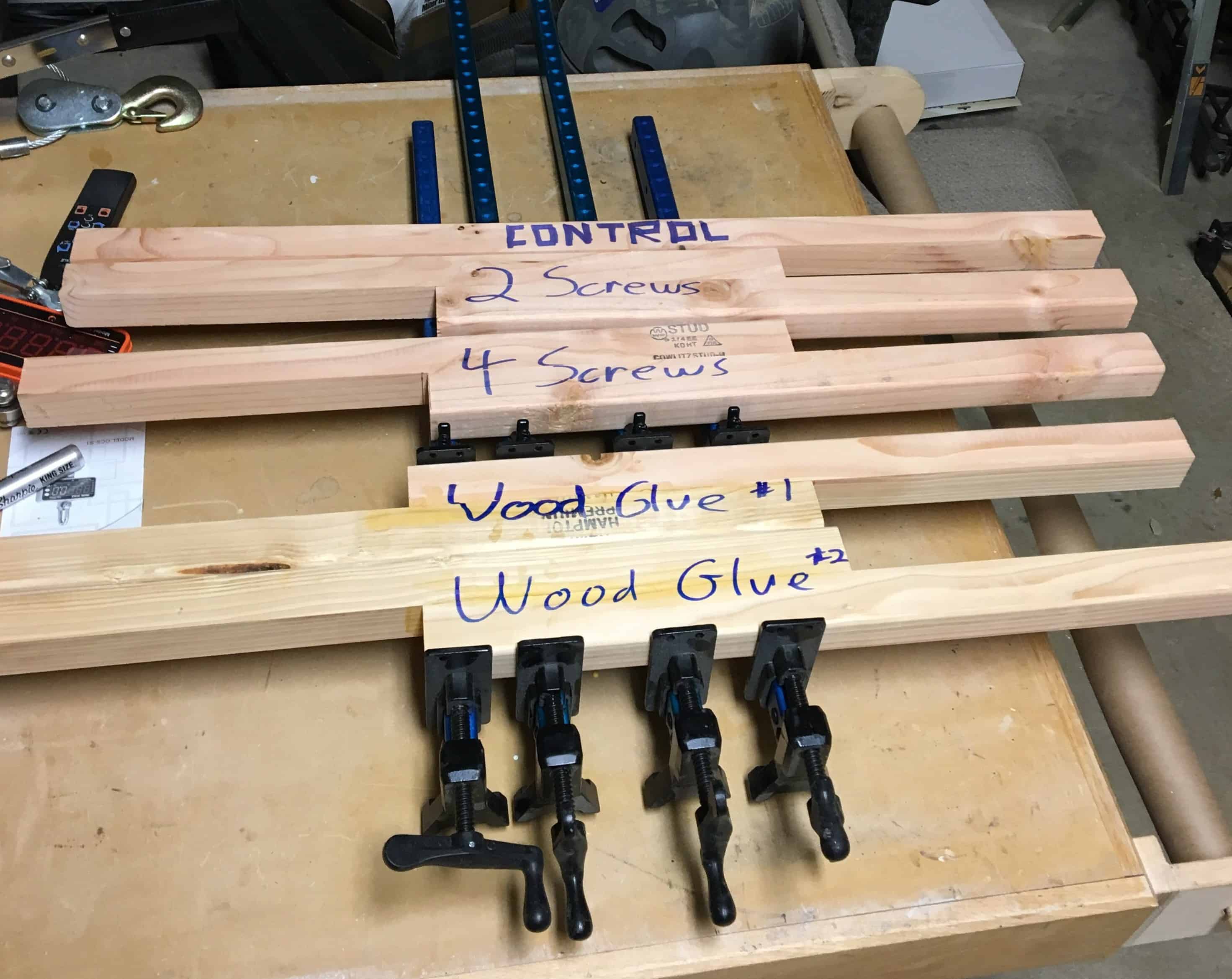Did you ever wonder if wood glue is stronger than nails? It’s a common question among DIY enthusiasts and woodworking enthusiasts. The decision between using wood glue or nails for your projects can impact the strength and durability of your final product. So, let’s dive into this age-old debate and find out which one comes out on top.
When it comes to joining pieces of wood together, wood glue offers some unique advantages. Not only does it create a strong bond, but it also distributes the stress evenly across the entire surface. This can make the joint even stronger than using nails alone. But nails come with their own benefits too. They provide structural support and can withstand heavier loads compared to an adhesive bond.
So, which is stronger? It’s time to put wood glue and nails to the test and see which one emerges as the victor. Let’s explore their strengths, weaknesses, and find out which option is the best for your woodworking projects. So, without further ado, let the battle of wood glue versus nails begin!
When it comes to strength, wood glue and nails have their own advantages. Wood glue forms a strong bond that can withstand constant tension and shear forces. Nails, on the other hand, provide a reliable grip and are suitable for structural applications. It’s best to use a combination of both. Glue the wood joints for added strength, and then reinforce them with nails. This combination ensures a sturdy and durable bond.

Is Wood Glue Stronger Than Nails?: The Ultimate Showdown
Woodworking enthusiasts are often faced with the age-old question: Is wood glue stronger than nails? Whether you’re crafting a DIY project or embarking on a professional construction endeavor, understanding the strengths and weaknesses of different joinery methods is crucial. In this article, we will delve into the debate and explore the advantages and disadvantages of wood glue and nails, allowing you to make an informed decision for your next woodworking project.
Benefits of Wood Glue
Wood glue, also known as carpenter’s glue or woodworking adhesive, has been a staple in the woodworking community for decades. One of the main benefits of wood glue is its ability to create a strong bond between two or more pieces of wood. When applied correctly and allowed to dry fully, wood glue forms a strong adhesive bond that can withstand substantial force. This bond is especially effective for large surface areas, such as tabletops and cabinets, where nails alone may not provide sufficient strength.
Another advantage of wood glue is its flexibility. Unlike nails, which can cause splitting or cracking, wood glue distributes stress evenly across the surface, minimizing the risk of structural damage. Additionally, because wood glue dries clear and doesn’t leave behind visible fasteners, it can enhance the aesthetic appeal of finished woodwork. Finally, wood glue is easy to use and readily available in most hardware stores, making it a convenient option for both professionals and hobbyists.
Drawbacks of Wood Glue
While wood glue offers numerous benefits, it’s important to consider its drawbacks as well. One significant disadvantage is the extended drying time required for wood glue to cure fully. Depending on the type of wood glue and environmental conditions, curing can take anywhere from a few hours to several days. This can significantly slow down the construction process and prolong project timelines. Additionally, wood glue is not reversible, meaning that once it’s applied and cured, it cannot be easily undone without damaging the wood.
Another drawback of wood glue is its limited versatility. While it excels at bonding large surface areas, it can be less effective for small or delicate pieces, as the glue may seep through joints and mar the appearance of the wood. In situations where precise alignment is crucial, such as in intricate joinery or furniture assembly, nails may be a more practical option. Finally, wood glue requires smooth and clean surfaces to achieve maximum adhesion. Any debris, oils, or stains present on the wood may hinder the glue’s effectiveness, resulting in a weaker bond.
Benefits of Nails
Nails, on the other hand, have long been the go-to fasteners in the construction industry. One of the primary advantages of using nails is their convenience and speed. With a hammer or nail gun, nails can be quickly driven into the wood, saving time and effort. This makes nails well-suited for projects that require efficiency, such as framing or rough carpentry. Additionally, nails offer versatility in terms of size, shape, and material, allowing for customization based on the specific woodworking needs.
Another benefit of using nails is their strength in shear force. While wood glue excels at providing tensile strength, nails are particularly effective at withstanding lateral forces, such as pressure or movement from different directions. This makes them ideal for load-bearing applications or structures that may be subject to significant stress. Additionally, nails provide a level of adjustability, allowing for disassembly or modifications if needed.
Drawbacks of Nails
Despite their convenience and strength, nails do have some drawbacks that need to be considered. One of the most significant concerns with nails is the potential for splitting or weakening the wood. When driven into the wood, nails can cause cracks, especially in thin or brittle pieces of wood. This can be particularly problematic for decorative or high-end woodworking projects where aesthetics are crucial. Additionally, nails are visible and can detract from the overall appearance of the finished piece if not properly concealed or incorporated into the design.
Another drawback of nails is their inability to provide a seamless bond between two pieces of wood. While nails can securely hold pieces together, they do not create a continuous surface-to-surface connection like wood glue does. This lack of continuity can result in weaker joints, especially in applications where forces are not distributed evenly across the entire joint. Furthermore, nails may become loose over time due to wood movement or environmental factors, requiring periodic maintenance or reinforcement.
Conclusion
In the age-old debate of whether wood glue is stronger than nails, the answer ultimately depends on the specific requirements of your woodworking project. Wood glue excels at providing a strong, seamless bond for large surface areas, enhancing the structural integrity and aesthetic appeal of finished woodwork. On the other hand, nails offer convenience, speed, and versatility in load-bearing applications and projects that require adjustability.
To make the best decision, consider the size and nature of your project, the desired appearance, the forces the joints will endure, and the time constraints you may have. In many cases, a combination of both wood glue and nails can provide the optimal balance of strength and convenience. By understanding the benefits and drawbacks of each joinery method, you can choose the right approach to ensure the success of your woodworking endeavors.
Key Takeaways – Is Wood Glue Stronger Than Nails?
- Wood glue is incredibly strong and can bond wood pieces together effectively.
- Nails provide a mechanical connection and can offer additional support to the glued joints.
- Combining both wood glue and nails can create a stronger bond than using either one alone.
- Wood glue is better for joining larger surfaces, while nails are ideal for securing pieces together quickly.
- Consider the project requirements and type of wood when deciding whether to use wood glue or nails.
Frequently Asked Questions
Curious about the strength of wood glue compared to nails? We’ve got you covered! Below are some commonly asked questions about whether wood glue is stronger than nails.
1. What are the advantages of using wood glue over nails?
Wood glue offers several advantages over nails. First, it creates a stronger bond as it adheres to the entire surface area, whereas nails only penetrate the wood at specific points. This even distribution of force makes the joint more durable. Additionally, wood glue dries clear, leaving no visible marks or holes that nails would normally create. This makes for a cleaner and more aesthetically pleasing finish.
Another advantage of using wood glue is its ability to fill gaps and cracks in the wood, creating a more solid connection. Gluing also eliminates the risk of splitting wood and reduces the likelihood of long-term joint failure, as it provides greater flexibility and resilience to changes in temperature and humidity.
2. Are nails stronger than wood glue?
While nails have their own strength and durability, wood glue can often be stronger under certain circumstances. Nails provide mechanical strength by physically fastening pieces of wood together, whereas wood glue creates a chemical bond that adheres the fibers of the wood. This bond can potentially be stronger than the physical strength of nails.
It’s important to note that the application and type of joint also play a significant role. In some cases, nails may be more suitable, such as when an immediate holding force is required, or for certain load-bearing structures. Ultimately, the choice between nails and wood glue depends on the specific project and its requirements.
3. Can wood glue replace nails entirely?
Wood glue can be used as a substitute for nails in many woodworking projects, particularly when aesthetics and joint longevity are important factors. In furniture making or cabinetry, where a clean and seamless appearance is desired, wood glue can often replace nails entirely. It creates a stronger bond and eliminates the need for visible fasteners.
However, there are instances where nails are still preferred. For construction projects that require high holding strength or structures subjected to significant stress and movement, nails may still be necessary to ensure the stability of the joint. In such cases, nails and wood glue can even be used together for added strength and support.
4. How long does wood glue take to dry and bond?
The drying time of wood glue depends on various factors such as humidity, temperature, and the type of glue used. However, most wood glues reach initial bond strength within 30 minutes, allowing you to continue working on the project. It’s advisable to wait at least 24 hours for the glue to fully cure and reach maximum strength before subjecting the joint to heavy stress.
Keep in mind that different types of wood glue may have specific instructions and drying times, so always refer to the manufacturer’s recommendations for the best results.
5. Does the quality of wood glue affect its strength?
Yes, the quality of wood glue does affect its strength. Higher quality wood glues are formulated with superior adhesives and improved bonding agents, resulting in a stronger bond. Cheaper or lower-quality glues may not provide the same level of strength and durability, potentially compromising the integrity of the joint.
When working on important projects, it’s worth investing in a reputable wood glue brand known for its strength and reliability. This ensures that the bond formed is long-lasting and can withstand the test of time.

Which Wood Glue Is The Best?
Summary
Wood glue and nails each have their own strengths when it comes to holding things together. Nails are great for strength and durability, while wood glue is excellent for providing a strong bond and flexibility.
However, when it comes to comparing their strength, wood glue actually has the potential to be stronger than nails. This is because wood glue spreads evenly over a larger surface area, creating a strong connection between the pieces of wood. On the other hand, nails rely on friction and can sometimes loosen over time.
In conclusion, both wood glue and nails have their advantages, but if you’re looking for a stronger bond, wood glue may be the better choice. Just remember to choose the right adhesive for your woodworking projects!
